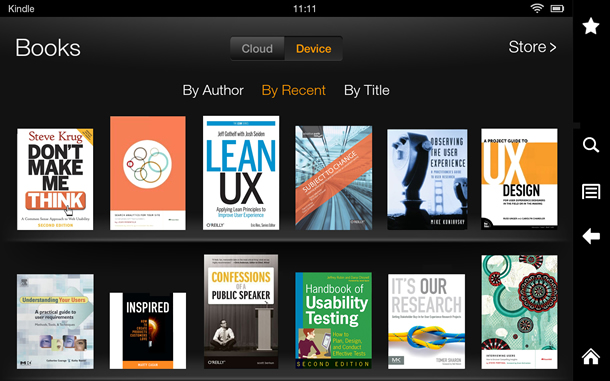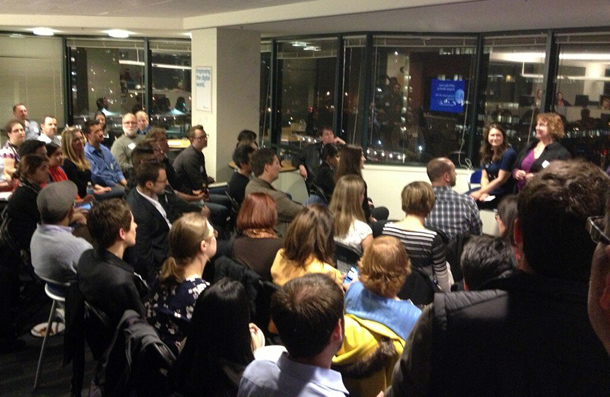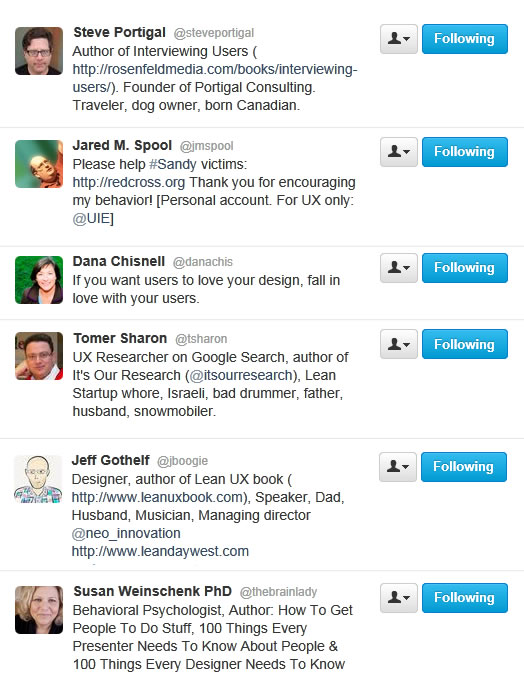
I’ve had the opportunity to meet many eager-to-get-into-the-field UX enthusiasts throughout my career. One of the first questions they often ask is, “How do I get started in user experience research?” It’s a hard question to answer because our field is relatively new and constantly evolving. Some researchers, including myself, fall into the career when working on a product team that is trying to figure out what to build. Others realize their passion and head to school in order to transition into user research. Regardless of your path, there’s a host of skills to learn, some directly related to conducting research, and others that help you champion it in your organization.
This article provides advice and resources I’ve collected from UX mentors and experts as I progressed in my career as a user researcher. Whether you’ve just started considering a career in UX, or are already a seasoned professional, I hope this collection will be a valuable resource as you take your career to the next level.
Build Your Foundation by Reading Books on UX Research
My first foray into user research came when the CEO of FirstGiving told me to start conducting usability studies and slapped a book on my desk. From that moment forward, I’ve been reading as many books as I can on UX research (see Figure 1). Here are some of the books I found helpful back when I was getting started, as well as those I reference today:
- Don’t Make Me Think: A Common Sense Approach to Usability by Steve Krug. Krug’s book is a short, easy-to-read, and approachable introduction to UX research. It makes a strong argument for conducting research, which you can share with others on your team who may need convincing. It also encourages empathy for users and teaches you how to foster that empathy in others, while providing all the information you need to get started in conducting your own research.
- Understanding Your Users: A Practical Guide to User Requirements (Methods, Tools, and Techniques) by Catherine Courage and Kathy Baxter. Courage and Baxter’s book is a UX bible that includes all you need to know about UX research: the purpose of various methodologies, step-by-step guidelines, and real-world examples of how methodologies have been applied by seasoned researchers.
- Subject to Change: Creating Great Products and Services for an Uncertain World: Adaptive Path on Design by Peter Merholz, Todd Wilkens, Brandon Schauer, and David Verba. Through case studies and descriptions of different techniques, this book explains how research fits into the design process, as well as how to approach design collaboratively.
This is by no means an exhaustive reading list, but these are the books you should grab off your bookshelf if your house is on fire. You’ll find them timeless and a great foundation for building your career in user research.

Surround Yourself with Other Researchers by Attending UX Networking Events
Many user research teams are small; some consist of only one person. It can feel lonely at times. Fortunately, there are many great ways to meet other researchers, and one of the best ways is to attend UX events. Events get you out of your office and open your mind to novel techniques and new ways to solve problems. They also provide opportunities to learn from, and connect with, other UX professionals. Here are some examples of events to attend:
- UXPA Chapter Meetings. UXPA has more than forty local chapters, many of which meet on a regular basis (see Figure 2). The format of these meetings allows for plenty of interaction with other UX practitioners by providing time to network, encouraging attendees to discuss their challenges and successes, and hosting speakers who present on a variety of UX issues. UXPA chapter meetings are also a great place to connect those looking for a job with those hiring.
- Special Interest Group on Computer-Human Interactions (SIGCHI). SIGCHI has local community groups that meet regularly. For instance, the San Francisco Bay Area chapter, BayCHI, holds monthly lecture-style meetings, during which UX enthusiasts can listen to intriguing and inspiring talks by other UX professionals. Networking happens before presentations start, so you need to be sure to arrive early.
- Meetup.com. If there’s a topic that you’re interested in, go to meetup.com and search for it. When picking a meetup, consider how active the group is; be sure to check for recent events and how many members are in the group. The San Francisco LeanUX meetup is informative and fun—meetings usually start off with a short talk followed by a design challenge everyone works on together. If I was in New York City, I would probably check out the Agile Experience Design meetup. If I was in London, I’d stop in and visit the Café UX meetup.
Find or Create Your Opportunities to Gain UX Experience
All too often, hiring managers turn away candidates because they don’t have any experience. This can be extremely frustrating when the reason you don’t have experience is because you can’t get hired! How do you gain experience out of thin air? Here are two examples of how you can create your own opportunity:
- Find a way to conduct UX research in your current role. Design challenges do not only happen on digital interfaces. When I was a project manager, our company implemented a process that was supposed to be better for the entire organization. Colleagues began adopting this new process but, at some point, the momentum slowed. Another project manager and I conducted contextual inquiries with colleagues in a variety of roles impacted by this new process. Later, we analyzed our findings, suggested some adjustments to the new process, and communicated our results and recommendations to the entire company.
- Offer to help. There’s never a shortage of research projects in UX. After you’ve met some UX professionals at events, or if you work in a company that has a research team, ask if anyone needs help. When I first started my career in UX, most of the skills I acquired were through helping and working alongside other user researchers. I recruited participants for studies, took notes when they facilitated, attended and observed every meeting that they were in, and asked a lot of questions to understand why they did what they did.
Get Comfortable with Public Speaking
No matter how insightful your research results are, if you can’t communicate your findings, it’s as if the research never happened. In addition to getting the word out, the more confident you are when you convey your research results, the more assured your audience will be of you and your results. Public speaking is not something that comes easily to everyone, but rest assured that constant practice builds confidence. Here are two resources I’ve used in the past in practicing my public speaking skills:
- Toastmasters. Toastmasters is an international public speaking club that provides regular opportunities to practice speaking and gain feedback on how to improve, all within a supportive environment. I regularly attend Toastmasters meetings to practice my speaking skills, including impromptu speaking. Practicing impromptu speaking helps you respond to questions when you bump into your CEO and she asks how that project is going.
- Confessions of a Public Speaker by Scott Berkun. Berkun’s book provides great tips to help you get over your fear of public speaking. It’s written in a fun, frank way (it feels like your good friend is giving it to you straight), with many tips, including chapters on what to do before you speak and how to manage those nerves.
Keep Your Fingers on the Pulse with Social Media
Perspectives and practices in UX are constantly evolving. To keep your career growing, and to stay on top of the latest trends, techniques, and tools, you need to pay attention. A good way to stay informed is by engaging with other UXers via social media.
Here are some blogs that I read regularly:
- Silicon Valley Product Group blog. Product legend Marty Cagan and his team continuously post helpful advice and examples on how to make great products. One aspect of Marty’s blog that is helpful for user researchers is insight into what product managers consider when building a product, such as business goals, technical feasibility, and of course, users’ needs.
- User Interface Engineering blog. Jared Spool’s company offers a plethora of resources online. Take your pick from great blog articles, webinars, and podcasts featuring Spool and other UX leaders, including Luke Wroblewski, Margot Bloomstein, and Kim Goodwin.
- UX Magazine, UX Booth, and UXmatters. These blogs crowdsource experiences and thoughts from the UX community. If you have a specific UX topic in mind, they can be great search engines, pointing you to articles by various UX professionals.
- AnswerLab’s blog. (Disclaimer: I work at AnswerLab, but I really do enjoy the blog posts!) This blog includes stories about UX research from the field, things we’ve learned or observed, and new techniques we’re trying. We’ve covered areas such as industry-specific research case studies and detailed methodology implications.
There are many UX experts that you should follow on Twitter, but here are just a few to help you get started (see Figure 3):
@steveportigal. Steve Portigal of Portigal Consulting and author of Interviewing Users: How to Uncover Compelling Insights tweets practical advice from the field. By following his twitter feed, you’ll also hear about his upcoming speaking engagements, which are always insightful.
@jmspool. Jared Spool’s satirical yet practical tweets are always good for a laugh, particularly when he points out some of the UX flaws of air travel. There’s often banter with other UX professionals and interesting observations about the field.
@danachis. Another great UX leader, Dana Chisnell, has been applying UX techniques to ballot design for elections. Her twitter feed gives updates on her progress and how she’s overcoming the challenges of research on a budget. In the past, she’s asked for volunteers to help with the ballot design project.
@tsharon. Author of the book It’s Our Research: Getting Stakeholder Buy-in for User Experience Research Projects, Tomer Sharon reminds us that research doesn’t happen in silos and of the importance of making your research the entire team’s research. Another bonus: Tomer often tweets links to the video interviews with other UX experts.
@jboogie. Jeff Gothelf is one of the first UX designers to promote Lean UX. His articles and webinars are practical and inspiring. Jeff, together with Josh Seiden, recently published a book Lean UX: Applying Lean Principles to Improve User Experience.
@thebrainlady. Susan Weinschenk applies behavioral psychology to realworld design problems. She also shares video teasers of her publications and other thought-provoking posts on her (blog).

Conclusion
The steps you take in your UX research career will not be the same as your friends’ or boss’s. Career paths can be complex and you need to find your own way. Build your library of resources by starting with those listed in this article and adding new ones that inspire you.
Keep sharing your favorite resources with the UX community by tweeting, commenting, blogging, or talking about them at an event. As you will find, the more you learn, the more opportunities you will encounter.
[greybox]The books shown in the image are:
- Don’t Make Me Think by Steve Krug
- Search Analytics for your Site by Lou Rosenfeld
- Lean UX by Jeff Gothelf
- Subject to Change by Peter Merholz, Todd Wilkens, Brandon Schauer, and David Verba
- Observing the User Experience by Mike Kuniavsky
- UX Design by Russ Unger and Carolyn Chandler
- Understanding Your Users by Catherine Courage and Kathy Baxter
- Inspired by Marty Cagan
- Confessions of a Public Speaker by Scott Berkun
- Handbook of Usability Testing by Jeff Rubin and Dana Chisnell
- It’s OUR Research by Tomer Sharon
- Interviewing Users by Steve Portigal
[/greybox]想知道如何开始您的用户研究职业生涯吗?阅读详情,了解基于多年指导和咨询经验提出的相关建议和资源。
“我如何在用户研究领域入门? ”这一问题很难回答,因为我们的这个领域总是在不断发展。有些研究人员直接进入这个职业道路,而另一些则根据自己的爱好进入学校深造。无论您选择什么样的道路,始终有大量的技能需要学习,大量的知识需要掌握。本文提供了 5 个步骤以及我作为用户研究人员在工作中收集的 20 种资源供您参考。
文章全文为英文版사용자 연구 활동은 어떻게 시작하는지 궁금하십니까? 수년간의 멘토 활동과 조언을 토대로 한 도움말과 자원을 원한다면 더욱 자세히 읽어보십시오.
“사용자 연구는 어떻게 시작하는가”라는 질문은 이 분야가 계속 진화하고 있기 때문에 답하기 어렵습니다. 직업 현장으로 뛰어들어가는 연구자가 있는가 하면, 자신의 열정을 깨닫고 학교로 향하는 이도 있습니다. 어떤 길을 가든 관계없이, 배워야 할 기술과 습득해야 할 지식은 많습니다. 이 기사에서는 내가 사용자 연구자의 길을 걸으며 수집한 5단계와 20개의 자원을 제시합니다.
전체 기사는 영어로만 제공됩니다.Imaginando como iniciar sua carreira em pesquisa com usuários? Leia mais sobre os conselhos e recursos baseados em anos de orientação e aconselhamento.
A pergunta “como iniciar no ramo de pesquisa com usuários?” é difícil de responder, pois nossa área está em constante evolução. Alguns pesquisadores entram nesta carreira por acaso, enquanto outros descobrem sua paixão e vão estudar. Independentemente do seu caminho, há uma série de habilidades a aprender e conhecimentos a adquirir. Este artigo fornece cinco etapas e 20 recursos que coletei ao longo da minha carreira como pesquisadora de usuários.
O artigo completo está disponível somente em inglêsユーザー研究のキャリアをどうスタートさせるか考えをめぐらせている読者は、何年ものメンタリングや相談の経験を元に書かれたアドバイスを読んで、関連するリソースを発見しよう。
「どのようにすればユーザー研究スタートできるか」という質問は、この分野が絶えず進化しているため、回答することが難しい。また研究者の中には偶然にこのキャリアに就くものもいれば、この分野に対する情熱を自覚し、学校で学ぼうとする者もいるが、どちらの場合でも、習得すべきスキルや学ぶべき知識が多数ある。この記事には、筆者のユーザー研究者としてのキャリアを通して得られた、5つステップと20のリソースが記載されている。
原文は英語だけになります¿Se pregunta cómo comenzar su carrera como investigador de experiencia de usuario? Continúe leyendo para obtener consejos y recursos basados en años de experiencia como mentor y asesor.
La pregunta “¿Por dónde comienzo en al campo de la investigación de experiencia de usuario?” es difícil de contestar porque nuestro campo está evolucionando permanentemente. Algunos investigadores llegan por casualidad a esta carrera, mientras que otros se dan cuenta de su pasión y acuden a la universidad. Independientemente de cuál fue el camino que usted siguió, hay muchas habilidades por aprender y conocimientos por adquirir. Este artículo brinda 5 pasos y 20 recursos que he recopilado durante toda una carrera como investigador de experiencia de usuario.
La versión completa de este artículo está sólo disponible en inglés
